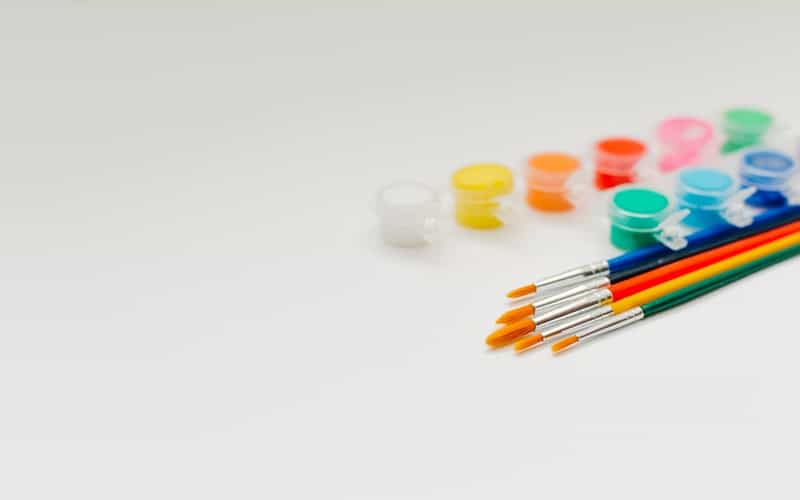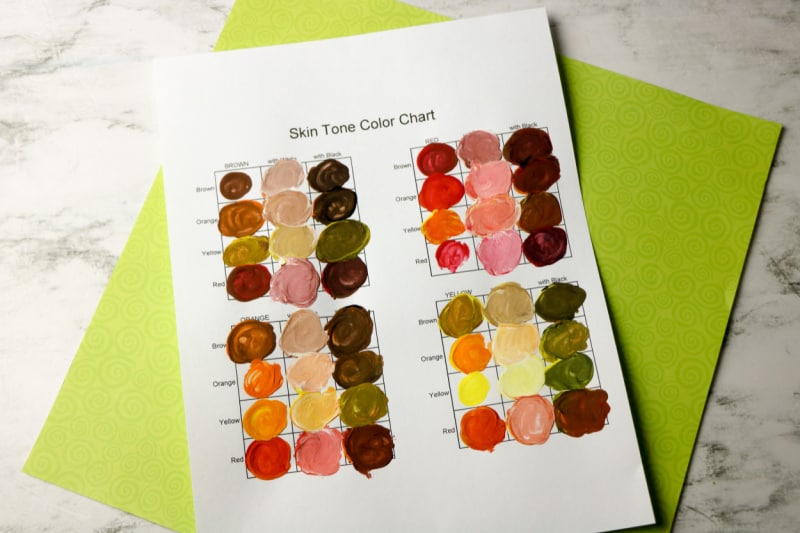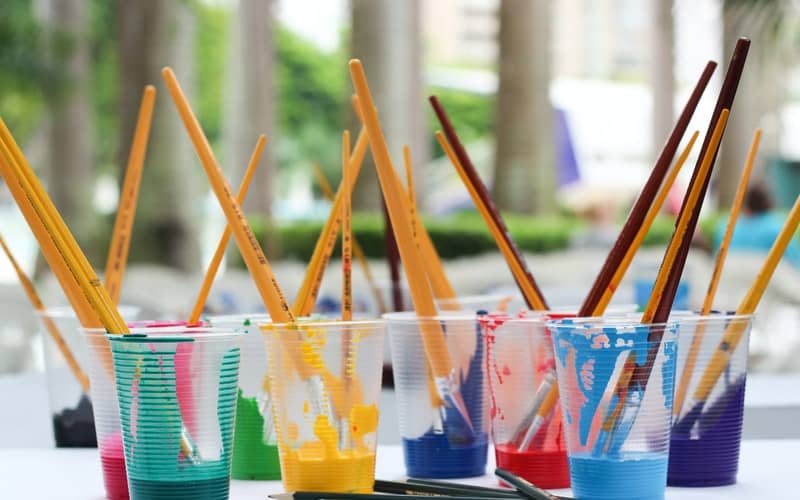Last Updated on October 13, 2022 by ellen
Do you have a hard time making skin tone colors for your children’s art projects? Learn how to make skin tone paint with this guide.
Posts may be sponsored. This post contains affiliate links, which means I will make a commission at no extra cost to you should you click through and make a purchase. As an Amazon Associate I earn from qualifying purchases.
We all know that it is important to teach our kids about different races and cultures. Being able to create art projects with different flesh tones helps make this easier.
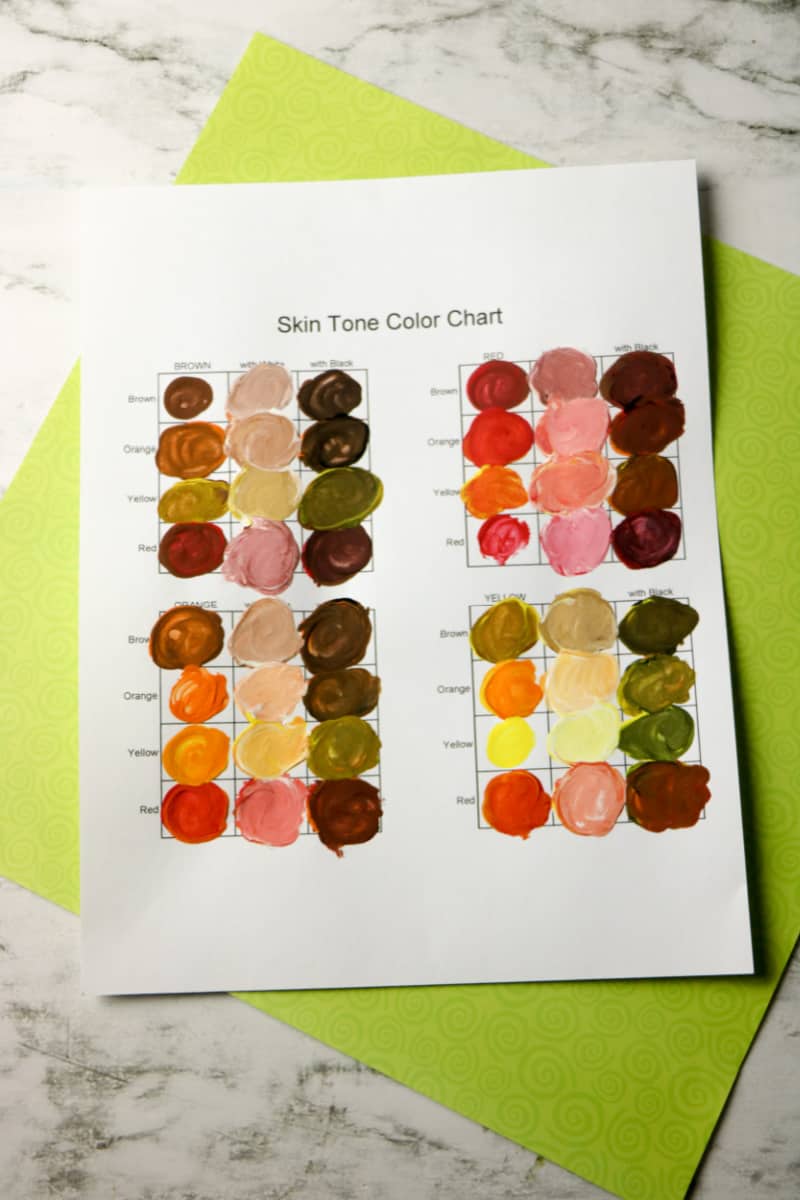
Table of Contents
How to Make Skin Tone Paint
Learn how to create a variety of shades so that you can achieve realistic skin color for many races. Once you know how to make flesh-colored paint, you have more options for your creation.
When painting, re-creating the correct natural colors is tricky, even for adults. Understanding color mixing is an essential skill to become an accomplished artist and this guide will help your child get started.
How to make skin colour
For skin tone painting it is even more challenging as it requires subtlety and learning to combine enough color to create the perfect effect. Techniques can help you find the perfect color of skin that you need.
How to mix skin color paints
Scroll to the end to find my helpful chart to learn to make basic shades of skin tones. You can mix skin color paints directly on this chart to make skintone.
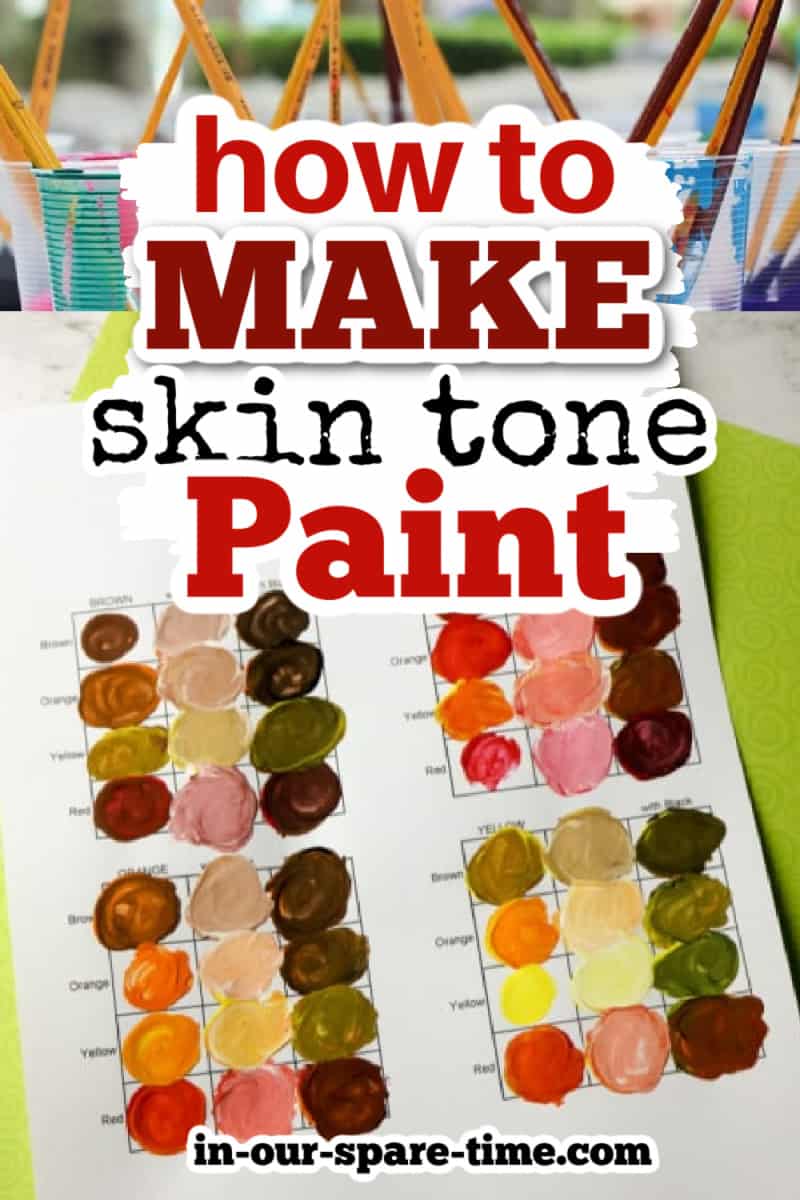
What are primary colors?
Primary colors are the three colors that can’t be mixed or formed by any other color. They include red, yellow, and blue. You will need them to make a mixed skintone.
What is secondary color?
A secondary color is a mix of two primary colors in equal amounts to form another distinct color such as purple, orange, and green. Take a look at the skin color mixing chart above.
Tertiary colors
Mixing a primary color with an adjacent secondary color will create a tertiary color. It is also known as the third level of colors which include yellow-orange, red-purple, blue-green, etc.
What colors make skin tone colors?
The color of human skin can vary greatly depending on race, physical conditions, and time of year. For the purposes of painting the following colors are considered to be in the range that represents human flesh tones:
- Cadmium red light or medium or slightly orangey-pink (warmer than typical roses)
- Burnt sienna
- Burnt umber
- Cerulean blue
- Permanent alizarin crimson
- Cadmium yellow light
- Cadmium orange
- Thalo blue
- Cadmium red deep
- Thalo green
- Primary yellow (also called lemon)
What colors do I need to make skin tone?
It is helpful to have the primary colors that are located in the color wheel above. When mixing you can create a range of colors from the primaries.
When mixing colors to create skin tone remember that you can always add more colors but it is very difficult to remove color without taking away the natural effect. It takes time and practice so be patient with your children as they learn this art form.
What is the best way to mix skin tones?
A color wheel is a great tool for learning how to mix colors when making skin tones.
Starting with the primary yellow, add small amounts of the other primary colors to create darker shades. For example, adding red will give you orange, and adding blue will create green. This is the best way to get realistic skin tone paint that is less garish than if you were to use secondary colors.
Mixing colors with white and black will help you to create different shades of skin tones that are more realistic than using one color alone. Using a combination of colors to achieve the color results in a higher quality paint job as well as helps your children learn about mixing colors properly.
Adding even small amounts of gray can also affect the tone of the paint.
Be patient with your child as they learn this skill. It is best to work on one color at a time so that you can see where the proportions of colors are off and adjust accordingly.
It takes time to learn to make different skin tones.
Where can I find skin color paint?
You can make your own skin tone paint or purchase some. Check out some of these colors to get you started!
The guide below will help you make different skin tones yourself by mixing paint. Or, you can buy acrylic paint that is already premixed.
It may take time to find the desired color if you want to buy paint colors that are already mixed.
How to make realistic skin tones
Painting skin tones takes practice so don’t expect your child to make the perfect flesh tone the first time they try. It’s really about experimentation and learning.
If you are working with a younger child, make sure they have a firm grasp on their primary colors first. To make skin color paint, they will need to be able to identify colors. So, be sure they understand the difference between black paint, titanium white, and blue paint.
How to make flesh colored paint
Print out this skin color mixing chart so that your child can experiment with making different skin shades.
By mixing different colors, they will learn to make a lighter shade or darker shade depending on what acrylic paints they put together.
As a basic rule, start with your base skin tone and then add brown or black for a darker skin tone.
How to make white skin tone
To make light skin tones, you will need to add white paint or yellow paint to brown paint. Experiment until you have the desired flesh tone for your child’s painting project.
Tips for mixing skin tones
Using a color chart can help you mix the perfect skin tone. If your child is using acrylic paint, it can be helpful to use colors that are premixed to get started. You will need to ensure that the colors they choose are non-toxic and safe for them to work with.
Remember this tip: The darker the shade of skin tone, the fewer colors it will require. The lighter skin tones need more colors to create a realistic effect.
You may also want to remind your child that while they can add more color to get a darker shade, it is difficult to remove color. If you have brown paint and add too much black to darken it, for example, it will become a dark gray rather than a brown.
You can try using white with black to make dark skin tones lighter, but this is often difficult to use in painting and may spread out unevenly compared to other colors which are thicker and easier to control.
Creating rosy cheeks or creating blush tones can be done by adding a very small amount of red to your flesh color. Remember that a vermillion red hue will not look as natural as a blush tone on lighter shades of skin.
Expect color variations
Don’t expect your child to get the exact same skin tone every time. The color will vary depending on the brand of paint or how much they add.
If you notice a large variation in colors, try adding a larger amount of white paint to the mixture next time to lighten it up. If you have added too much black, add more yellow. Keep experimenting until you get the desired color.
It may be easiest in the beginning for them to focus on a darker tone. It’s harder to make a medium skin tone when mixing acrylic paints.
Painting natural skin tones is not always easy, but it will help your child learn about mixing colors properly while they are having fun painting skin colors!

Paints for painting skin tones
I find that it’s easiest to make skin color with acrylic paint rather than oil paints. Plus, clean-up is much simpler when you use acrylics.
To make medium skin tones,
Try mixing 2 parts Titanium White, 1 part Burnt Sienna or Raw Umber, and then adding just a touch of Cadmium Red.
To make darker skin tones,
Use Burnt Sienna for an orange-brown base with Raw Umber blended in. To make it darker, add more Burnt Sienna or use Lamp Black or Ultramarine Blue to darken the skin tone.
To make natural tones,
Mix white with cadmium yellow light or mix yellow ochre and burnt sienna to make a natural flesh tone. Add just enough red to tint it slightly pink.
To create rosy cheeks, use vermillion red. Do not add too much at once if you are working with lighter tones. Experiment until you get the desired tone.
Supplies to get started painting skin tones
- Color wheel
- Acrylic paints
- Paintbrushes
- Skin color mixing chart
More painting fun
- Straw painting art
- Shamrock craft
- Host a painting party
- Rock painting flowers
- Beautiful painted rocks
- Flower pot painting for kids
- Rock painting designs

Ellen is a mom of a 25-year-old son and 30-year-old daughter. She is Grandma to one adorable toddler. In what little spare time she has, she loves to read, watch movies, and check out the latest toys and games.
